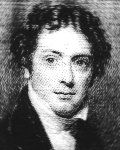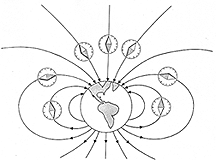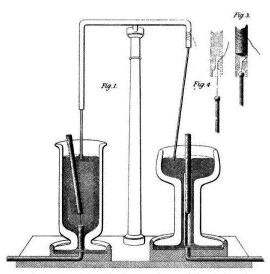(E20) Faraday and his "Lines of Force"In our homes, cars, communications, computing and machinery, electric currents are are usually channeled by insulation wrapped around wires and boundaries. On the other hand, mapping the structure of the Earth's magnetism across continents and oceans makes one think of effects spread out in space. Both channeled and unbounded phenomena exist and have their uses: information can be spread by both insulated telegraph wires and freely propagating radio waves. Two names stand out in the study of spread-out electric and magnetic phenomena in the 19th century: the Englishman Michael Faraday and the Scot James Clerk Maxwell--one an intuitive observer, the other a gifted mathematical scientist. 
Michael Faraday was born in England In 1791, to the family of a blacksmith. His formal education stopped early, after which he was apprenticed to a bookbinder, providing cheap labor in return to learning a trade (Ben Franklin was similarly apprenticed to his brother, a printer). As books came to the shop to be rebound, Michael found opportunities to read them. Among them was a volume of the Encyclopaedia Britannica, summing up what was then known about electricity. Anothe bright light of British science in the early 1800s was Humphry Davy, who "lived in the odium/of having discovered sodium." He did so by passing an electric current through molten table salt NaCl; salt dissolved in water would not do, because there, any molecule of NaCl broken up would break up a water molecule H20 , create NaOH and HCl, and these would recombine to give again NaCl. He similarly separated potassium from its salt Kcl, also invented the extremely bright electric arc lamp, also a safety lantern for coal miners and more. Not too long before that, the USA gained its independence from Britain, and one supporter of the crown in that war ("tory") was Benjamin Thompson of Rumford, near Boston. Thompson had to flee to England and later acquired the title "Count Rumford" in the service of a German prince. With some scientists, Rumford founded the "Royal Institution" in London for promoting science in Britain, and Davy gave there popular public lectures on the world of science. (The Royal Institution still exists, and now includes--among others--a museum devoted to Faraday). Faraday managed to attend the lectures and kept detailed notes. When Davy fired an assistant for brawling, Faraday--now older--applied for the position, sending along his notebook as evidence of earnestness. He was hired, rose to become Davy's secretary and prime assistant, and in later years, his rival.
Magnetic Field LinesFaraday's main asset was his clear intuition, reflected in his lucid style in writing and lecturing. He also excelled in chemistry, kept detailed notebooks and was active in the Sandemanian church. To visualize magnetic forces, he imagined space around a magnet filled with a huge bundle of lines each of which, like a drawn arrow, had a definite direction, giving at any point the local direction of magnetic force. That is, the direction in which the north-seeking pole ("N pole") of a freely suspended compass needle would point, and in which a free-floating magnetic N-pole would be pushed by magnetic forces. He named them magnetic lines of force, though nowadays "magnetic field lines" is the usual term. 
With the Earth's north-south magnetic force, these lines fan out from the vicinity of the south magnetic pole, arch above the (magnetic) equator and converge again in the region around the northern magnetic pole. Lines of latitude and longitude on Earth are just a visualization--one can be drawn through any point on Earth. Were magnetic field lines like that too (but in three dimensions)? Faraday was not sure--a space filled with magnetic field lines did not seem to him empty any more. This ambiguity still persists. Yes, they are just a visualization, pure mathematical abstractions. But they are also uniquely useful, in applications such as labeling the motion of electrons in space near a magnet. They seem to give only the direction of the magnetic force, not its strength--but their global configuration allows strength to be deduced, since they cluster more densely wherever the magnetic force is stronger. A related concept, "magnetic flux," is extremely useful in designing machinery (and will come up in a later section). And yes, space around electric currents and charges, as we see it today, is not really empty but has specific properties (such as energy density). Today we call such modified space a "field"--a magnetic field, electric field or electromagnetic field. Many of these ideas started with Faraday's "lines of force," though (as discussed later) they were also foreshadowed by the study of fluids. "Magnetic Rotations"As Oersted demonstrated, an electric current in a wire also created magnetic forces, but in that case the field lines were closed loops around the current flow. Since compass needles tend to line up in the direction of the local field line, this explained why Oersted observed them trying to become oriented perpendicular to the wire. Field lines also trace the force on an isolated magnetic N-pole. Such isolated poles do not exist, but it is possible to observe forces on them if the corresponding S-pole is far enough to be hardly affected. In 1821, after Oersted had published his findings, Faraday (possibly with Davy's advice) devised a clever experiment to do so.In a goblet filled with mercury--a dense metal liquid at room temperature and conducting electricity--Faraday immersed a long iron bar magnet (iron floats in mercury). One end of the magnet (say, the S-pole end) was tied flexibly to a hook at the bottom, while the other floated up at an angle, poking out near the rim of the goblet. A vertical metal rod held by a stand poked into the middle of the goblet (left image below) and connected to one side of a "voltaic pile" electric battery, while the other side was electrically connected to the mercury. When the circuit was closed, a current flowed through the rod, creating loops of field lines, and the floating N-pole end of the magnet circled around them. 
The S-pole in this case was tied down in one place, which served as pivot to the rotation. Reversing the battery connections reversed the rotation, as did exchanging the positions of the magnetic poles. By Newton's 3rd law of mechanics, all forces act symmetrically: whenever the current exerts a force on a magnetic pole, the pole exerts an opposite and equal force on the current. This allowed Faraday to demonstrate the reverse process as well: the magnet was now vertically fixed along the axis of the goblet (right-hand image), while the rod conducting the current hung at an angle from a supporting stand, its tip floating near the edge of the goblet. This time, when the battery was connected, it was the rod that rotated around a cone. In a way, these were the first electric motors--though not very efficient ones, since the currents they required were rather large. From experiments like this, Faraday devised his "right hand rule": stretch your right hand thumb and bend the other four fingers. If the thumb points in the direction of the current, the fingers curl in the direction in which field lines go around the wire.
|